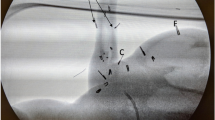Abstract
The high pressure zone (HPZ) is a result of a series of combative forces that converge in the gastroesophageal junction and contribute to generate the pressure barrier. Recognized factors in this function are the positive intra-abdominal pressure transmitted to the lower esophagus, thoracic suction, the diaphragmatic hiatus, the intrinsic lower esophageal sphincter, and the effect of gastric fundus acting on the distal esophagus through the His angle. The exclusive and quantitative role of the His angle is evaluated with the help of two experimental models (in vivo and in vitro) in the dog. By manometric procedures the gastric pressure at which the sphincter opens (OP) is studied under overloaded conditions, both in the living animal and in a gastroesophageal specimen, varying the His angle from 90° to 0°. In the “in vivo” model the pressure of the barrier with a His angle of 90° was 7.33 ± 3.4 mm Hg and the OP of 8.66 +- 4.1 mm Hg, while with the His angle at 0° the pressure of this barrier was 10.66 +- 2.9 mm Hg and the OP 16 +- 6.9 mm Hg (p < 0.05). In the “in vitro” model the His angle at 0° multiplied the OP two or three times. We conclude that the His angle at 0° allows transmission of the fundic pressure extrinsically to the sphincter, giving way to a higher OP, and increasing the degree of competence.
Similar content being viewed by others
References
Altschuler SM, Nixon TE, Boyle JT (1985) Crural diaphragmatic contraction: a component of the gastroesophageal antireflux mechanism. The American Pediatric Society and the Society for Pediatric Research. Abstract no. 608, p 212 A
Bardají C, Boix Ochoa J (1985) Contribución del ángulo de His al mecanismo anti reflujo gastroesofágico. Estudio experimental. XXV Congreso Internacional de la Sociedad Española de Cirugía Pediátrica y III Latino-Americano, Bilbao
Bardají C, Pettersson GB, Boix Ochoa J (1985) Estudio de la barrera antirreflujo gastroesofágico en el perro. III. Polsko-Hiszpanska Konferencja Naukowa Chirurgow Dzieciecych, Warszawa
Biancani P, Goyal RK, Phillips A, Spiro HM (1973) Mechanics of sphincter action: studies on lower esophageal sphincter. J Clin Invest 52: 2973–2978
De Meester TR, Wernly JA, Bryant GH, Little AG, Skinner DB (1979) Clinical and in vitro analysis of determinants of gastroesophageal competence. Am J Surg 137: 39–46
Friedland GW, Shoichi Kohatsu, Levin K (1971) Comparative anatomy, of feline and canine gastric sling fibers. Digest Dis 16: 495–507
Fyke FE, Code CE, Schlegel JF (1956) The gastroesophageal sphincter in healthy human beings. Gastroenterologia 86: 135–150
Gahagan T (1962) The function of the musculature of the esophagus and stomach in the esophagogastric sphincter mechanism. Surg Gynecol Obstet 293–303
Ingelfinger FJ (1958) Esophageal motility. Physiol Rev 38: 533–539
Ingram PR, Respess JC, Muller WH Jr (1959) The role of an intrinsic sphincter mechanism in the prevention of reflux esophagitis. Surg Gynecol Obstet 109: 659–664
Liebermann-Mefert D, Allgower M, Schmid P, Blum AL (1979) Muscular equivalent of the lower esophageal sphincter. Gastroenterology 76: 31–38
Mann CV, Ellis FH, Schlegel JE, Code CF (1964) Abdominal displacement of the canine gastroesophageal sphincter. Surg Gynecol Obstet 1009–1018
McLaurin C (1963) The intrinsic shphincter in prevention of gastroesophageal reflux. Lancet II: 801–805
Nauta J (1956) The closing mechanism between the esophagus and the stomach. Gastroenterologia 86: 219–224
Pera C, Suñer M, Capdevila J (1975) Anatomical demonstration of the lower esophageal sphincter: a biometrical analysis of 300 specimens. Bull Soc Int Chir 285: 34–39
Pettersson GB, Bombeck CT, Nyhus LM (1980) The lower esophageal sphincter: mechanisms of opening and closure. Surgery 88: 307–314
Pettersson GB, Bombeck CT, Nyhus LM (1980) The dynamics of lower esophageal sphincter function. Curr Surg 37: 143–145
Pettersson GB, Bombeck CT, Nyhus LM (1981) Influence of the hiatal hernia on lower esophageal sphincter function. An experimental study. Ann Surg 193: 214–220
Rinaldo JA, Levey JF, Smathers HM, Gardner LW, McGinnis KD (1971) An integrated anatomic, physiologic and cineradiologic study of the canine gastroesophageal sphincter. Digest Dis 16: 556–565
Author information
Authors and Affiliations
Additional information
Offprint requests to: J. Boix-Ochoa at the above address
Rights and permissions
About this article
Cite this article
Bardají, C., Boix-Ochoa, J. Contribution of the His angle to the gastroesophageal antireflux mechanism. Pediatr Surg Int 1, 172–176 (1986). https://doi.org/10.1007/BF00180919
Received:
Issue Date:
DOI: https://doi.org/10.1007/BF00180919




